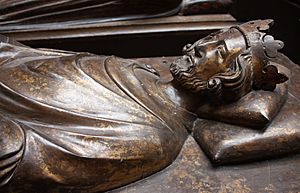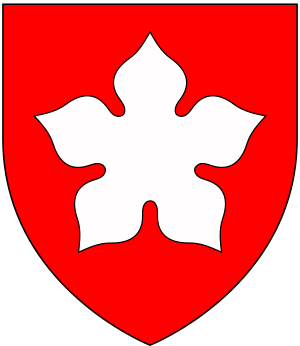Falkes de Bréauté facts for kids
Sir Falkes de Bréauté (died 1226) was a brave soldier from Normandy who became very important by serving two English kings, King John and later King Henry III. He fought loyally for them during a big conflict called the First Barons' War. He played a key part in a famous battle known as the Battle of Lincoln Fair in 1217. Later, he had a disagreement with another powerful leader, Hubert de Burgh, which led to him losing his power in 1224.
People often say his special symbol was a griffin, which is a mythical creature. Interestingly, the Vauxhall car company uses a griffin as its badge today. This is because Falkes de Bréauté's wife owned a house in London that was called "Fawkes Hall." Over time, this name changed to "Foxhall" and then to "Vauxhall." The car company got its name from this area of London.
Contents
Early Life
Falkes de Bréauté came from a simple background in Normandy. Some people thought he might have been from the village of Bréauté. Many writers at the time said he was from common people, not a noble family.
Serving King John
Falkes de Bréauté started serving King John around 1206. He was sent on important missions. When he returned, he was put in charge of several areas and was made a knight. He became a constable, which meant he was in charge of castles like Carmarthen and Cardigan. He became known as a strong and tough leader in the Welsh Marches.
In 1212, he was sent to deal with Strata Florida Abbey because they opposed the king. However, the abbey was saved after its leader paid a large fine. Falkes often served the king in places like Flanders and Poitou. He was very well-liked by King John. Some people mistakenly think he was against the Magna Carta, but he actually promised to follow its rules.
Falkes became very powerful during the First Barons' War because he always supported King John. This made many noblemen and church leaders dislike him. In 1215, he became King John's steward. He captured Hanslope and Bedford Castle, and King John let him keep Bedford Castle as a reward.
In 1216, King John divided his army, and Falkes was one of the main captains. When Prince Louis of France invaded England, Falkes was given the job of defending Oxford. He and the Earl of Chester attacked Worcester because it had sided with Prince Louis. As a reward, King John arranged for Falkes to marry Margaret, a wealthy widow. Her first husband had been the heir to the Earl of Devon. This marriage made Falkes as powerful as an earl, as he managed the Earldom until his stepson grew up. He also gained control of the Isle of Wight. When King John died, Falkes helped carry out his will. He also helped to re-issue the Magna Carta in November 1216.
Serving King Henry III

Falkes de Bréauté continued to be very loyal to King Henry III. In November 1217, a new version of the Magna Carta was published, along with a Charter of Forests. That Christmas, King Henry and his regents stayed at Falkes's castle in Northampton. Falkes was in charge of several areas as a High Sheriff, including Cambridgeshire, Oxfordshire, and Bedfordshire. This made him a big problem for Prince Louis and the barons who were against the king.
In January 1217, Falkes's men attacked St Albans because it had made a deal with Prince Louis. They attacked the people and then the abbey, leaving only after getting a lot of money. His men also attacked Wardon Abbey. Even though he later paid back St Albans, people felt he only did it to please his wife.
Falkes played a very important role in the events leading up to the Battle of Lincoln Fair. He joined the Earl of Chester to attack Mountsorrel. This made the rebels split their forces. Prince Louis stayed to attack Dover, while the rest went north to help Mountsorrel. After that, the rebels marched to Lincoln to help their forces who were attacking Lincoln Castle. The town of Lincoln had fallen to the rebels, but the castle remained loyal to King Henry.
When the rebels arrived, the king's army, led by William Marshal, 1st Earl of Pembroke, was already there. A big battle happened in the streets of Lincoln. Before the fight, Falkes led his soldiers into the castle. His crossbowmen shot down at the rebels from the castle walls. Falkes himself charged out of the castle so fiercely that he was captured for a moment before his men rescued him. He kept fighting until the rebels ran away. Even the French leaders admitted that Falkes was key to this important victory.
After the Battle of Lincoln, the royal court celebrated Christmas at Falkes's expense in Northampton. This was the peak of his career. However, after the battle, many fighters, including Falkes, started to disagree with Hubert de Burgh, who was a very powerful royal official. The problem was that these fighters wanted to keep the castles they had captured for themselves. Because of his important role in the war and the victory at Lincoln, Falkes remained powerful for several years. He managed to keep his High Sheriff positions. He also served as a judge in some areas. When the 5th Earl of Devon died, Falkes was given the castle of Plympton.
Falkes had made many enemies during the war. One was William Marshal, who had trouble getting his lands back from Falkes. Another was the Earl of Salisbury, who disliked Falkes for supporting someone else to be constable of Lincoln Castle. Because Falkes was not from a noble family, his position was less secure than his enemies'. He relied on the support of powerful noblemen like the Earl of Chester and Peter des Roches, the Bishop of Winchester, who also disliked Hubert de Burgh. In 1222, Falkes worked with Hubert de Burgh to stop a revolt in London. They captured and punished the leaders of the revolt.
Rebellion and Downfall

Hubert de Burgh was becoming more and more powerful, which pushed Falkes and his allies closer together. But tensions exploded in November 1223. Hubert de Burgh and the king had to escape to Northampton when Falkes and other powerful earls tried to take the Tower of London. A new civil war was almost started, but Simon Langton, the Archbishop of York, stepped in and stopped it. After talks in London failed, tensions rose again.
Falkes and his allies were threatened with being kicked out of the church. On December 30, they agreed to give their castles and sheriff positions back to the king. Falkes immediately lost Hertford Castle and his sheriff roles in Oxfordshire and Northamptonshire. By January 1224, he had lost all his sheriff positions.
This failure gave Hubert de Burgh an advantage. In February 1224, he ordered Falkes to give up Plympton and Bedford castles. Falkes refused, saying Plympton Castle was part of his wife's inheritance. So, the king's court sent judges to Falkes's land with a made-up charge. They found him guilty of many counts of wrongful taking of land. On June 16, Falkes's brother, William de Bréauté, captured one of the judges who had ruled against them. This was a very bad idea because the King and his court were nearby. On June 20, the king and his army attacked Bedford Castle. The Archbishop Simon Langton also kicked both brothers and their soldiers out of the church. The attack on the castle lasted eight weeks. Many people inside the castle were killed. After a fourth attack broke the walls, William and 80 knights were captured. They were not forgiven and were hanged.
Exile
After losing Bedford Castle and his brother, Falkes gave up to King Henry III on August 19. He begged for forgiveness and gave up all his belongings. At this point, his wife left him and asked for a divorce, saying she had been forced into the marriage. She didn't get a divorce, but she did get some of her lands back. On August 25, Falkes officially gave up his lands and chose to go to France instead of facing judgment from the noblemen.
When he arrived in Normandy, he was put in prison by King Louis VIII as revenge for Falkes defeating the French during the war. But he was released in 1225, possibly because the Pope helped him or because he had a special badge showing he was a crusader. After being released, he spent several months in Rome. He wrote a long defense of his actions, blaming Langton and de Burgh. He asked the Pope to support him, saying he was wrongly kicked out of the church and was a crusader. On his way to England, Falkes was captured in Burgundy by an English knight he had once imprisoned. But the Pope helped him again, and he was released. After this, he lived in Troyes, but was kicked out of France in 1226 for not showing respect to the king. He stayed in Rome again and died shortly before July 18, possibly from eating poisoned fish.
Vauxhall Connection
The area of London known as Vauxhall was originally part of a large estate owned by the de Redvers family in the 1200s. The name Vauxhall (which was once "Fauxhall") comes from Falkes de Bréauté. He was the second husband of Margaret, who was the widow of Baldwin de Redvers.
In 1857, the Vauxhall Ironworks company was started in the Vauxhall area of London. They made steam pumps and boat engines. In 1903, the company built its first Vauxhall car. In 1905, they moved to a new factory in Luton, Bedfordshire, because land was cheaper there and they had more room to grow. By chance, Falkes de Bréauté had also owned the land of Luton between 1216 and 1226. So, the Vauxhall company moved from his London home area to his country estate area! The griffin symbol from Falkes de Bréauté's coat of arms was used in both Vauxhall and Luton for centuries. The company was renamed Vauxhall Motors in 1907 and still uses the griffin as its badge today.


